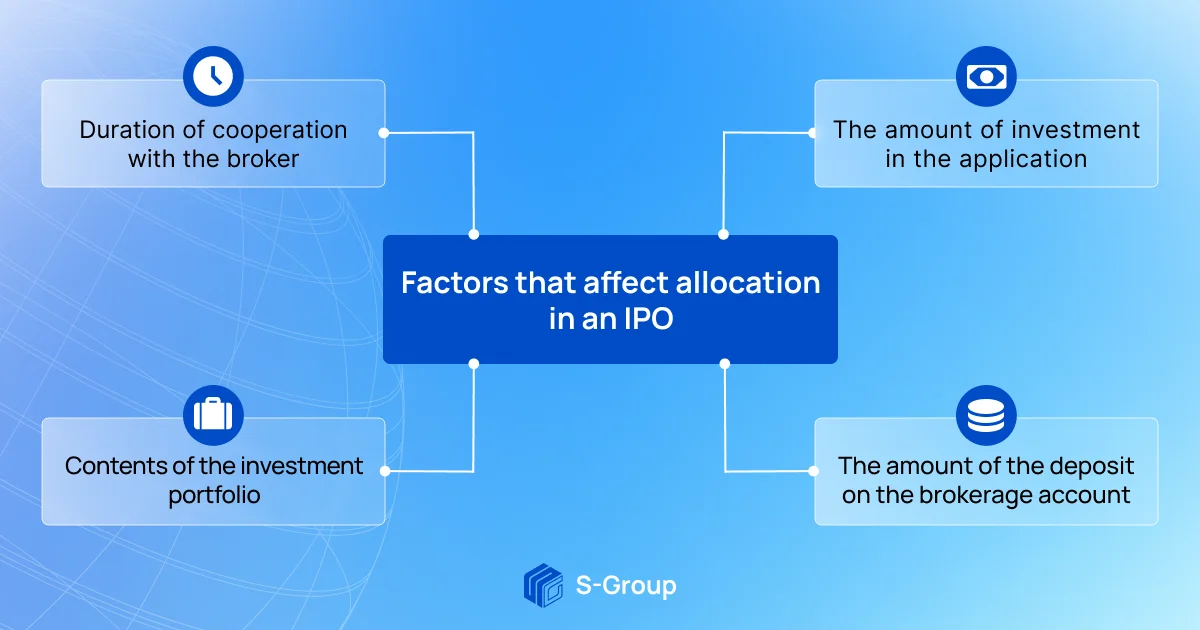IPO Allocation Process: Definition and Examples

When a large company is ready to go public and scale, it enters the international market through an IPO. This tool helps companies to attract new investments, and investors to buy securities below market value.
Before an IPO, a company issues a fixed number of shares, which depends on its economic model. The process of distributing assets among interested investors is called allocation.
What is an allocation, how does it affect the income of an investor, and how does the process of asset allocation work? We tell in the article.
What is an allocation in an IPO?
In preparation for the initial public offering (IPO) on the market, the underwriting company (investment bank) evaluates the demand for the securities of the issuer (the company that participates in the IPO) and fixes the number of shares to be sold. After that, the shares are placed on brokerage sites. Investors who are interested in them analyze the company's economic model, business strategy and growth potential. After that, they request for purchase of the shares and indicate the desired number of shares to buy.
An allocation in an IPO is the distribution of the shares of the issuing company among investors who have requested for their purchase by a broker. After processing all requests, the broker compares the expected demand with the actual one. As a result, there can be two scenarios.

Real demand for assets is lower than expected. A company participating in an IPO might not be of interest or inspire confidence among potential investors. Then the requests for the purchase of its shares may be less than expected. In this case, all submitted requests will be approved in full. For example, if an investor requests a broker for 500 shares, he receives all 500 shares, and the allocation percentage is 100%.
Real demand for assets is higher than expected. A more common option for the stock market. After processing and counting all requests, the broker determines that the demand for the shares of the issuing company is higher than the offer. In this case, he can only partially implement requests by distributing shares among investors. For example, in an investor's request there were 400 shares, but after distribution by the broker, he receives only 200. The percentage of allocation of such a request is 50%.
Share allocation process

Once the applications have been processed, the share allocation process begins. The broker determines the allocation for each individual investor. The percentage of allocation for an investor depends on several factors.
- Duration of cooperation with the broker. If an investor has been registered on a brokerage site for a long time and uses its tools, the percentage of allocation of his request will be higher than that of new users.
- The amount of investment in the application. The broker gives priority to applications with the largest amounts.
- Contents of the investment portfolio. To increase the priority of the application, the investor must diversify assets, understand investments and use various financial instruments.
- The amount of the deposit in the brokerage account. The number of free assets that an investor uses in investments positively affects the percentage of his allocation.
Brokers have a mechanism that spells out the criteria for allocating the number of shares to investors. For example, some brokers focus on the regularity of the investor's financial activity. That is, if an investor actively uses the broker's tools, regularly makes transactions on the account, diversifies the portfolio competently, the chance to get a priority in the allocation may be higher. At the same time, some brokers work according to a different scheme and distribute shares in an equal share among investors.
Let's consider the allocation process with an example.
The underwriting company preliminary estimates the demand for the issuer's securities, after which the company places 4,000 shares at an IPO.
An investor submits a request to buy 200 shares at a price of $10 each. The amount of the request is $2,000, and the number of investors is 100. The total number of shares in requests is 20,000.
After processing all applications, the broker distributes 4,000 shares in equal shares among investors. As a result, each investor receives an approved purchase application for 40 shares. In this case, each application is sold for $400, the percentage of allocation is 20%.
The remaining $1,600 from each request is returned to the investors' account.

In an IPO, there are cases when the allocation can be zero and the investor does not purchase a single share. Then the amount of the application is returned to him in full.
Impact of allocation on investor income
A small percentage of allocation does not always mean low income. If a company has a good reputation, a growing industry, and a well-thought-out business strategy, the demand for its shares in an IPO is higher than the supply. In this case, after entering the stock market, the value of the shares may increase in price.
For example, the Immuneering Corporation (IMRX) stock price at its IPO in July 2021 was $15. After the end of the lock-up period, the share price rose to $27, and the return on investment was 80%. Investors who bought the company's shares before going public made good profits even with a low allocation percentage.
There are reverse cases, when the share price falls after the company's IPO. In such a situation, the higher the percentage of allocation of the investor's application, the greater his loss from the investment.
The allocation percentage does not affect whether the investor receives a profit or loss, but affects their size.

Conclusions
Before investing in an IPO, investors should carefully analyze the companies, their potential, and business strategy in order to receive a return on investment even with a low percentage of allocation.
An investor can increase the chances of a high allocation by actively using the tools of the brokerage platform, diversifying assets and increasing the amount of investment.
Share
Interesting
Would you like to receive a digest of articles?
One email with the best articles of the week.
Sign up so you don't miss anything.